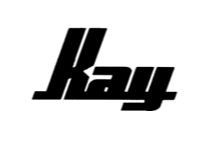The roots of the Kay Musical Instruments company began back in 1890, when the Groeschel Company of Chicago, Illinois first began building bowl-back (or potato bug) mandolins. In 1918, Groeschel was changed to the Stromberg-Voisenet Company, and incorporated in 1921. Vice-president C.G. Stromberg directed production of guitars and banjos under the Mayflower trademark (see Mayflower). This Stromberg is not to be confused with luthier Charles Stromberg (and son Elmer) of Boston, Massachusetts. Stromberg-Voisenet introduced the process of laminating wood tops and backs in 1924, and also began arching instrument tops and backs. Henry Kay Kuhrmeyer, who later became company president, offered use of his middle name on the more popular Kay-Kraft series of Stromberg-Voisenet´s guitars, mandolins, and banjos.
The Kay era began when Henry Kay Kuhrmeyer bought the Stromberg-Voisenet company in 1928. Kuhrmeyer renamed the company Kay Musical Instruments in 1931, and began mass-producing stringed instruments. Kay, like Washburn at the turn of the century, claimed production of almost 100,000 instruments a year by the mid-1930s. Kay instruments were both marketed by the company itself, and produced for jobbers (distributors) and retail houses under various names. Rather than produce a list here, the Blue Book of Electric Guitars has attempted to identify Kay-produced House Brands throughout the alphabetical listing in this text. Many of these instruments were entry level or student instruments then, and should be considered entry level even now. But as Jay Scott (author of '50s Cool: Kay Guitars ) points out, "True, the vast majority of Kay´s student-grade and intermediate guitars were awful. But the top of each line - banjo, guitar and mandolin (especially the acoustic and electric jazz guitars and flattop acoustics) - were meritorious pieces of postwar musical art."
Kay introduced upright basses in 1937, and marketed them under both the Kay trademark and K. Meyer (a clever abbreviation of Kuhrmeyer?). After Leo Fender debuted his Precision electric bass at the 1951 NAMM trade show, Kay was the first company to join Fender in the electric bass market as they introduced their K-162 model in 1952. Kay also went on to produce some of the coolest mixtures of classic archtop design and ´50s modern acrylic headstocks on the "Gold K" line that debuted in 1957.
The Kay Musical Instrument company was sold to an investment group headed by Sydney Katz in 1955. Katz, a former manager of Harmony's service department, was more aggressive and competitive in the guitar market. Kay's production facilities expanded to try to meet the demand of the guitar market in the late 1950s and early 1960s. A large number of guitars were produced for Sears under their Silvertone trademark. At the peak of the guitar boom in 1964, Kay moved into a new million dollar facility located near Chicago's O'Hare Airport.
Unfortunately, by 1965 the guitar market was oversaturated as retail demand fell off. While Kay was still financially sound, Katz sold the company to Seeburg. Seeburg, a large jukebox manufacturer based in Chicago, owned Kay for a period of two years. At this time, the whole guitar industry was feeling the pinch of the state of the economy. Seeburg wanted to maintain its niche in the industry by acquiring Valco Guitars, Inc. (see National or Dobro) and producing their own amplifiers to go with the electric Kay guitars. Bob Keyworth, the executive vice-president in charge of Kay, suggested the opposite: Seeburg should sell Kay to Valco.
Robert Engelhardt, who succeeded Louis Dopyera in Valco's ownership in 1962, bought Kay from Seeburg in June 1967. Valco moved into the Kay facilities, but Engelhardt's company was under-financed from the beginning. Engelhardt did make some deal with an investment group or financial company, but after two years the bills couldn't be paid. The investment group just showed up one day and changed the plant locks. By 1969 or 1970, both Valco Guitars Inc., and the Kay trademark were out of business.
The rights to the Kay name were acquired by Sol Weindling and Barry Hornstein, who were importing Teisco Del Rey (Kawai) guitars to the U.S. market with their W.M.I. importing company. W.M.I. began putting the Kay name on the Teisco products in 1973, and continued on through the 1970s.
In 1980, Tony Blair of A.R. Enterprises purchased the Kay trademark. The Kay trademark is now on entry level/beginner guitars built in Asia, (1950s/1960s company history courtesy Jay Scott, '50s Cool: Kay Guitars; contemporary history courtesy Michael Wright, Vintage Guitar Magazine).
Instruments currently produced in China. Previously built in Chicago, IL between the 1930s and the late 1960s and in Japan during 1970s. Distributed by the Kay Guitar Company in Newport Beach, CA. See chapter on House Brands.











